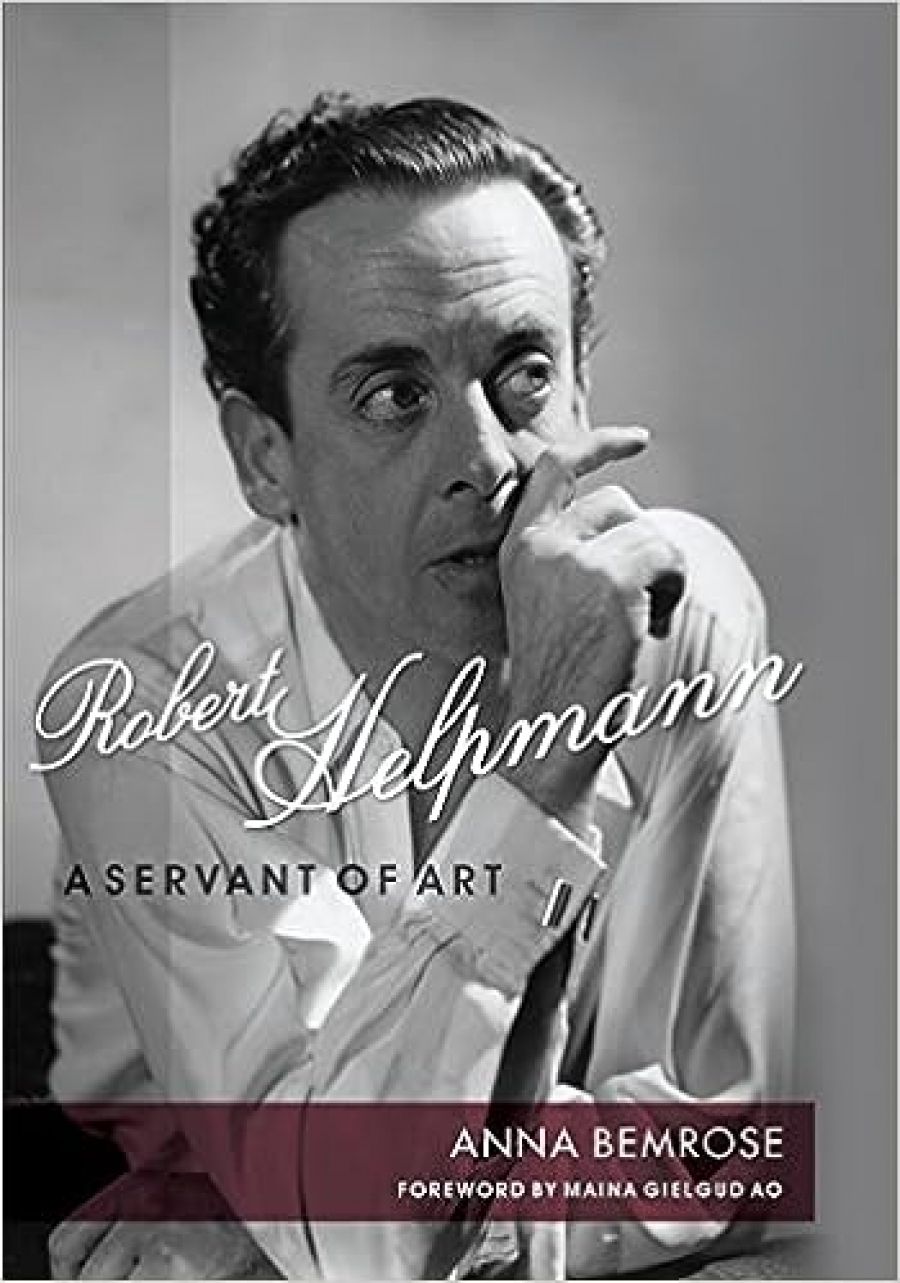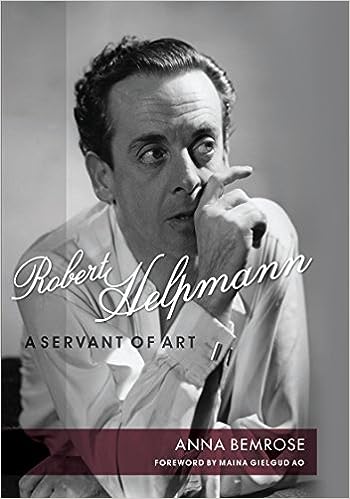
- Free Article: No
- Contents Category: Biography
- Review Article: Yes
- Article Title: The person defying the group
- Online Only: No
- Custom Highlight Text:
PANACHE. Both in its literal meaning (a plume of feathers) and its more familiar extended one, the term might have been invented for stage critic extraordinaire Kenneth Tynan as plausibly as for Robert Helpmann, one of last century’s most flamboyant and versatile stage practitioners. The illegitimate Tynan’s middle name was Peacock (the surname of his Birmingham father). Helpmann (born plain Robert Murray Helpman – one ‘n’ – in Mount Gambier, South Australia) will always be associated with the lyrebird, nominal subject and central symbol of perhaps his most original creative achievement, The Display, the dance-drama he choreographed for the Australian Ballet in 1964. In looks, each was very striking – and strikingly alike, though Helpmann was eighteen years older than Tynan, and their common resemblance (below as well as above the neck) was more to some exotic, sinuous reptile than to any species of bird.
- Book 1 Title: Robert Helpmann
- Book 1 Subtitle: A Servant of Art
- Book 1 Biblio: UQP, $49.95 hb, 403 pp
- Book 1 Cover Small (400 x 600):

Tynan, as far as I know, never saw The Display, but some twenty years prior to its première, when he was still a provincial English schoolboy, he showed in some casual remarks on Helpmann that empathetic susceptibility to extravagant talent that became one of the hallmarks of his mature criticism. It went, as always, with a shrewd appraisal of the performer’s limits. Helpmann was then (in 1944) at the peak of his reputation in England as a dancer, having left Australia in 1932. He was currently dancing opposite Margot Fonteyn in Giselle. Tynan observed of this performance in a letter to a former schoolfellow: ‘dancing is poetry with arms and legs; and Helpmann is dancing incarnate … but he seems happier out of classical ballet. she [Fonteyn] is, I imagine, a more reliable person than her erratic, statuesque partner. his is the creative genius, and hers the interpretors [sic].’
This firsthand appraisal is not quoted in Anna Bemrose’s so-called ‘career biography’ of Helpmann, and, alas, you’ll find nothing as crisply discriminating in her retrospective appraisal, nothing to match such verbal aplomb, mirroring the dynamic dandyism of its subject. Maybe we should not expect performance criticism to be any more ‘theatrical’ than we would expect poetry criticism to be poetic – and it is arguable that Tynan too often wrote just for the sake of effect. But a figure like Helpmann, especially, surely deserves a treatment that is more than routinely prosaic. In contemporary Anglophone writing about dance and dancers, the benchmark in stylishness (or should one say the barre?) has been set by Joan Acocella and Alastair Macaulay. There are also Julie Kavanagh’s wonderfully compendious and evocative biographies of Helpmann’s colleague and rival Frederick Ashton (1996) and of Rudolf Nureyev (2007). Bemrose cites these books in her bibliography, though there is no clear evidence that she has used them even for reference, let alone learned from, built on or refined the shining models they provide.
Part of the problem is that the book sits uneasily between the categories of performance criticism and biography, and rarely achieves an effective fusion of the two. (It is curious that the author nowhere describes her work as a biography; that word appears only on the publisher’s media release.) There is a whole chapter on The Display, and this comes the nearest to relating the work to the life and sensibility of its creator, as well to the contexts of time and place. But there are only eight chapters in all (or ten, if you include the prologue and the epilogue), so that the treatment of many other aspects of Helpmann’s career is bound to seem rushed, skated over, skimped, by comparison. At times the narrative threatens to descend into a mere catalogue of productions or an anthology of contemporary reviews. This may be of some use to scholars of theatre and dance, though even for them the only substantial advance it makes on the information provided in Elizabeth Salter’s ‘authorised’ biography of Helpmann, published in 1978, is to fill in the record of his achievements in his remaining eight years.
These last achievements were as varied as ever (a range of lavish and erudite productions for the Australian Opera, extensive film and stage work in England as well as Australia, a revival of The Display, plus guest appearances as a dancer with the Australian Ballet just weeks before he died), and it is good to have them on the record. When Bemrose, however, has Helpmann appearing in ‘Valmouth … Sandy Wilson’s production of Ronald Firbank’s eccentric musical’, she is clearly jumbling up Wilson’s musical adaptation with the original Firbank novel, and one has to wonder how much direct knowledge she has of what she is recording. Of more serious concern is her general failure to grasp the opportunities of a new study (especially one with biographical pretensions) to broaden and deepen her predecessor’s approach. There remain deficiencies in two areas: cultural politics, and sex.
The dust has now long settled on what was probably the stormiest episode in Helpmann’s career: the premature termination of his position as director of the Australian Ballet at the end of 1975 by the board of the Australian Ballet Foundation. Bemrose makes an attempt, but a rather perfunctory one, to sift through the dust, quoting from a couple of items in the archives of the Australian Ballet for that period, and from follow-up correspondence of her own with participants in the controversy or contemporary observers. But all we are left with is a cluster of impressions and opinions about what happened (similar to what we find in Salter) rather than any systematic analysis of the evidence now available, or considered explanations and conclusions that would help to place the controversy in a wider context. (Personally speaking, I can’t wait for a good historian to tackle the whole question of the relations in this country between arts boards and the people they appoint to senior arts positions. Why do these relations become so toxic so often?)
Reading Kavanagh’s Nureyev saga, you might, if you are perverse, think there is too much sex in it. To complain that there is too little in Bemrose’s book on Helpmann runs the risk of being told that there is not enough evidence, or that, if this book is a biography at all, it is a career biography. It is true that with Helpmann you might never find evidence of sex in the workplace, whereas Rudi’s nightly queue of hopeful stagedoor studs is the stuff of popular legend, when not of fact, eagerly and monotonously attested by those who ‘got lucky’. But with Helpmann, as with Nureyev, there is evidence everywhere of a sexual sensibility in the work. Salter (understandably discreet about Helpmann’s private life while he was still alive) was perfectly prepared to acknowledge this component, describing him at one point as ‘the man who believes ballet is a sexual art’.
Bemrose, on the other hand, won’t take the cue even from her own detailed evidence in the chapter on The Display. Quoting Helpmann’s assertion that this ballet was ‘actually about me … The person defying the Group. The person who was not behaving according to the accepted norm’, she glosses with almost culpable blandness: ‘Through the character of the Outsider Helpmann alludes to his own anxieties about punishment inflicted on those seen to be nonconformists.’ This is to take discretion to the brink of coyness.
Bemrose also pays no heed to the thirty-six-year personal relationship between Helpmann and the handsome old-Etonian actor and entrepreneur Michael Benthall. At a point where it might seem opportune and relevant to air this, she simply quotes Helpmann, quoted by someone else, as saying: ‘I find emotion in my relationships to be far more important than sex.’ Salter quotes a slightly different version of this, but, recognising that it may not be the full or the only story, wryly chips in, ‘on the surface this seems to be an unlikely statement’. The ‘emotion’ in this case would be worth exploring anyway, as one of the fuels of the substantial creative collaboration between the two men.
Bemrose, then, comes close to neutering her subject, or complying too readily with his strategic evasions. She hardly seems aware of the posthumous biographer’s freedom – responsibility, even – to consider the surfaces and probe whatever may lie beneath them. Her record, with all its useful new detail, merits a similar verdict to that of Donald Friend on a picture of Helpmann drawn in 1983 following some cosmetic surgery on his (once) electrifying face: ‘Judy Cassab showed me a black chalk portrait she’d made of him. It was quite smooth and characterless. “No lines or wrinkles,” she complained. Indeed, it was the record of a successful facelift.’


Comments powered by CComment